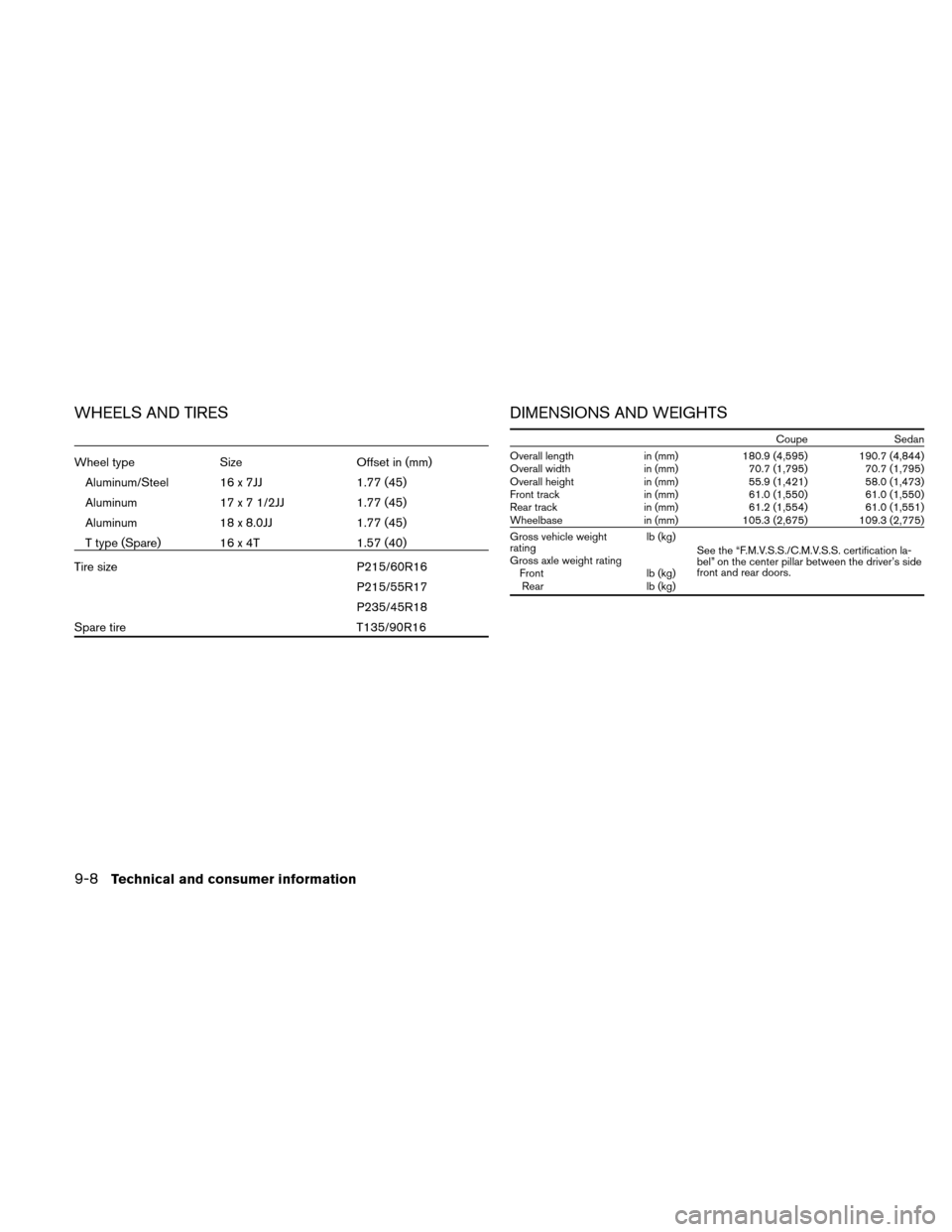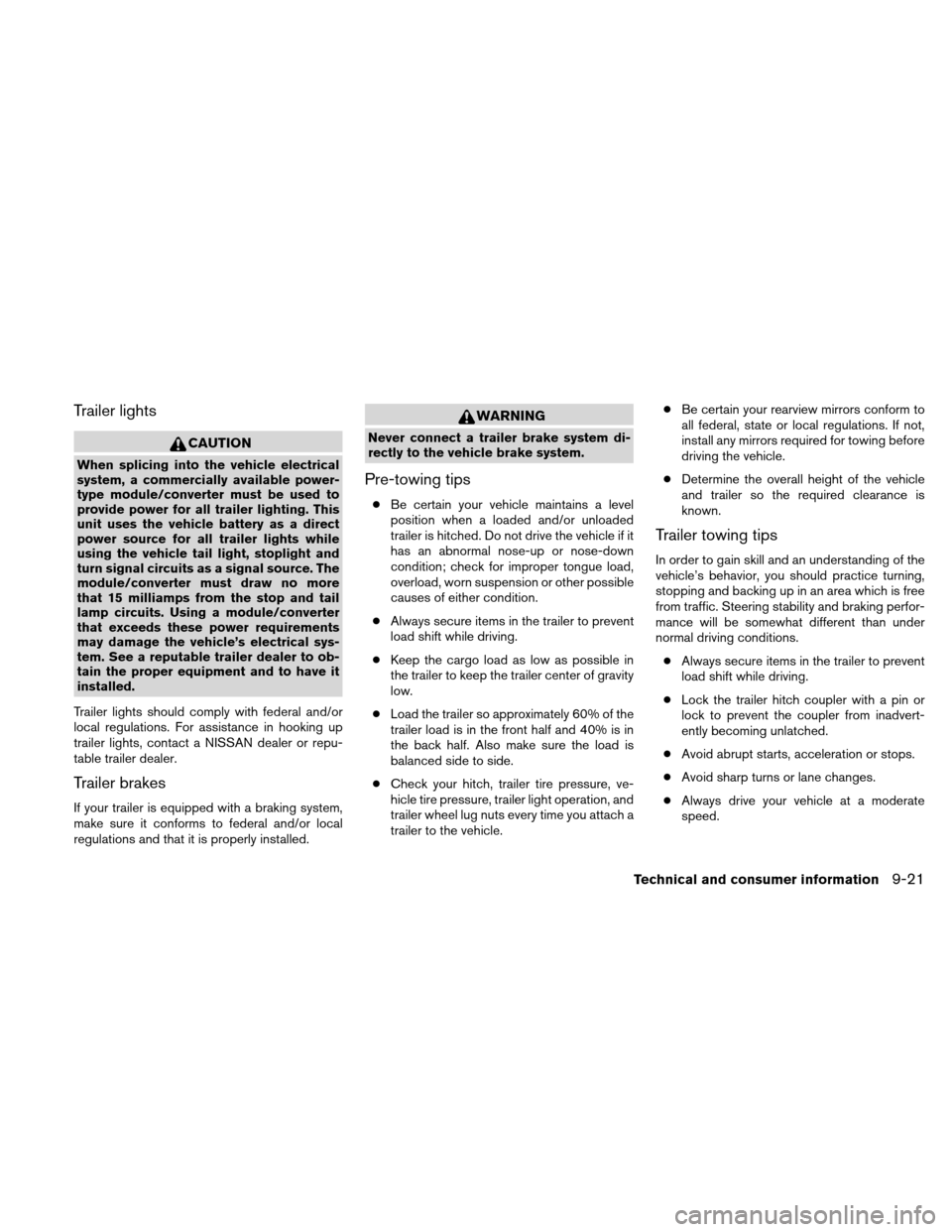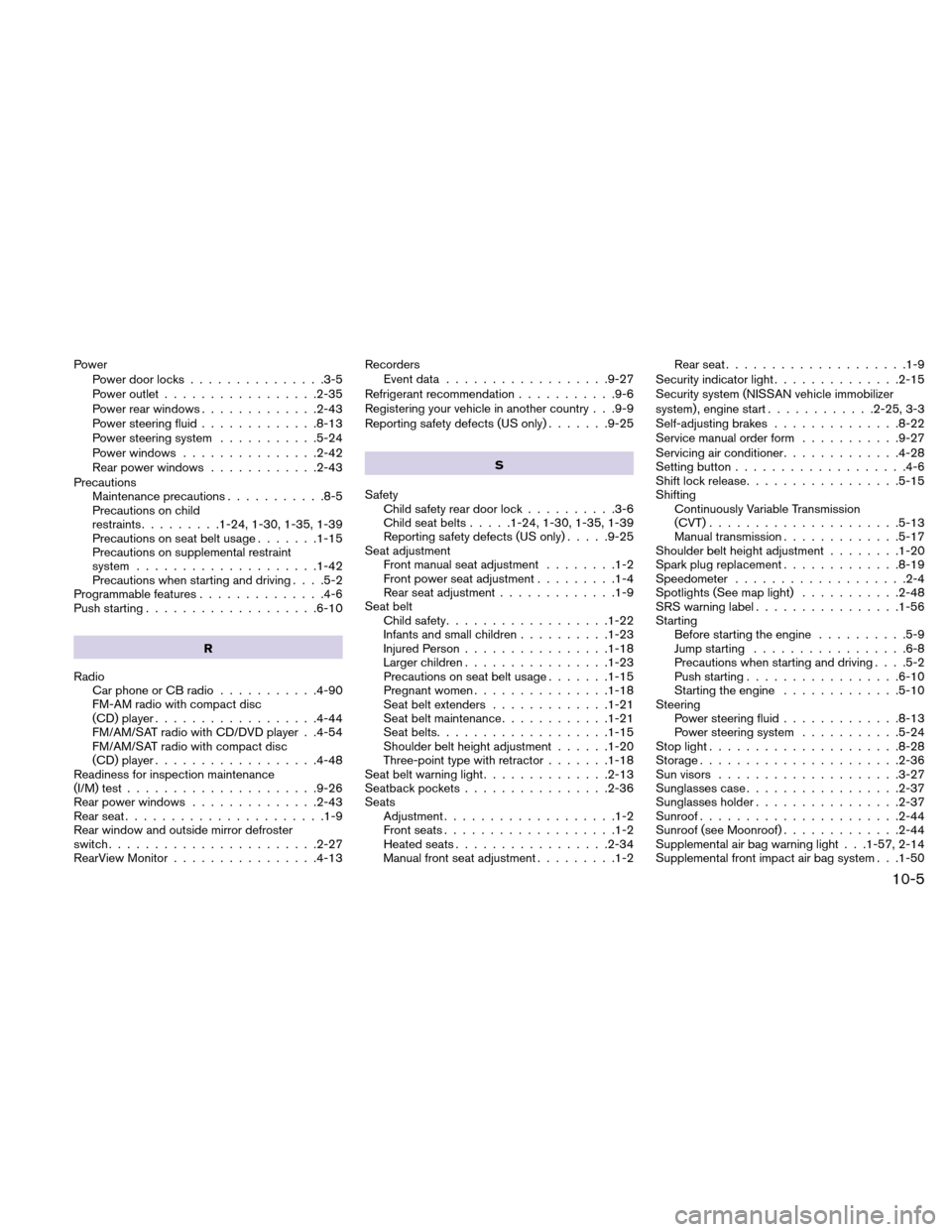2010 NISSAN ALTIMA COUPE height
[x] Cancel search: heightPage 401 of 440

●The original tires have built-in
tread wear indicators. When the
wear indicators are visible, the
tire(s) should be replaced.
● Tires degrade with age and use.
Have tires, including the spare,
over 6 years old checked by a
qualified technician because
some tire damage may not be ob-
vious. Replace the tires as neces-
sary to prevent tire failure and
possible personal injury.
● Improper service of the spare tire
may result in serious personal in-
jury. If it is necessary to repair the
spare tire, contact a NISSAN
dealer.
● For additional information re-
garding tires, refer to “Important
Tire Safety Information” (US) or
“Tire Safety Information”
(Canada) in the Warranty Infor-
mation Booklet.Replacing wheels and tires
When replacing a tire, use the same size, tread
design, speed rating and load carrying capacity
as originally equipped. Recommended types and
sizes are shown in “Wheels and tires” in the
“Technical and consumer information” section of
this manual.
WARNING
● The use of tires other than those recom-
mended or the mixed use of tires of
different brands, construction (bias,
bias-belted or radial) , or tread patterns
can adversely affect the ride, braking,
handling, VDC system (if so equipped) ,
ground clearance, body-to-tire clear-
ance, tire chain clearance, speedom-
eter calibration, headlight aim and
bumper height. Some of these effects
may lead to accidents and could result
in serious personal injury.
● If your vehicle was originally equipped
with 4 tires that were the same size and
you are only replacing 2 of the 4 tires ,
install the new tires on the rear axle.
Placing new tires on the front axle may
cause loss of vehicle control in some
driving conditions and cause an acci-
dent and personal injury. ●
If the wheels are changed for any rea-
son, always replace with wheels which
have the same off-set dimension.
Wheels of a different off-set could
cause premature tire wear, degrade ve-
hicle handling characteristics, affect
the VDC system (if so equipped) and/or
interference with the brake
discs/drums. Such interference can
lead to decreased braking efficiency
and/or early brake pad/shoe wear. Re-
fer to “Wheels and tires” in the “Techni-
cal and consumer information” section
of this manual for wheel off-set
dimensions.
● When a spare tire is mounted or a wheel
is replaced, the TPMS (if so equipped)
will not function and the low tire pres-
sure warning light will flash for approxi-
mately 1 minute. The light will remain
on after 1 minute. Contact your NISSAN
dealer as soon as possible for tire re-
placement and/or system resetting.
● Replacing tires with those not originally
specified by NISSAN could affect the
proper operation of the TPMS (if so
equipped) .
8-44Maintenance and do-it-yourself
Page 411 of 440

WHEELS AND TIRES
Wheel typeSizeOffset in (mm)
Aluminum/Steel 16 x 7JJ 1.77 (45)
Aluminum 17 x 7 1/2JJ 1.77 (45)
Aluminum 18 x 8.0JJ 1.77 (45)
T type (Spare) 16 x 4T 1.57 (40)
Tire size P215/60R16
P215/55R17
P235/45R18
Spare tire T135/90R16
DIMENSIONS AND WEIGHTS
CoupeSedan
Overall length in (mm)180.9 (4,595) 190.7 (4,844)
Overall width in (mm)70.7 (1,795) 70.7 (1,795)
Overall height in (mm)55.9 (1,421) 58.0 (1,473)
Front track in (mm)61.0 (1,550) 61.0 (1,550)
Rear track in (mm)61.2 (1,554) 61.0 (1,551)
Wheelbase in (mm)105.3 (2,675) 109.3 (2,775)
Gross vehicle weight
rating lb (kg)
See the “F.M.V.S.S./C.M.V.S.S. certification la-
bel” on the center pillar between the driver’s side
front and rear doors.
Gross axle weight rating
Front lb (kg)
Rear lb (kg)
9-8Technical and consumer information
Page 424 of 440

Trailer lights
CAUTION
When splicing into the vehicle electrical
system, a commercially available power-
type module/converter must be used to
provide power for all trailer lighting. This
unit uses the vehicle battery as a direct
power source for all trailer lights while
using the vehicle tail light, stoplight and
turn signal circuits as a signal source. The
module/converter must draw no more
that 15 milliamps from the stop and tail
lamp circuits. Using a module/converter
that exceeds these power requirements
may damage the vehicle’s electrical sys-
tem. See a reputable trailer dealer to ob-
tain the proper equipment and to have it
installed.
Trailer lights should comply with federal and/or
local regulations. For assistance in hooking up
trailer lights, contact a NISSAN dealer or repu-
table trailer dealer.
Trailer brakes
If your trailer is equipped with a braking system,
make sure it conforms to federal and/or local
regulations and that it is properly installed.
WARNING
Never connect a trailer brake system di-
rectly to the vehicle brake system.
Pre-towing tips
● Be certain your vehicle maintains a level
position when a loaded and/or unloaded
trailer is hitched. Do not drive the vehicle if it
has an abnormal nose-up or nose-down
condition; check for improper tongue load,
overload, worn suspension or other possible
causes of either condition.
● Always secure items in the trailer to prevent
load shift while driving.
● Keep the cargo load as low as possible in
the trailer to keep the trailer center of gravity
low.
● Load the trailer so approximately 60% of the
trailer load is in the front half and 40% is in
the back half. Also make sure the load is
balanced side to side.
● Check your hitch, trailer tire pressure, ve-
hicle tire pressure, trailer light operation, and
trailer wheel lug nuts every time you attach a
trailer to the vehicle. ●
Be certain your rearview mirrors conform to
all federal, state or local regulations. If not,
install any mirrors required for towing before
driving the vehicle.
● Determine the overall height of the vehicle
and trailer so the required clearance is
known.
Trailer towing tips
In order to gain skill and an understanding of the
vehicle’s behavior, you should practice turning,
stopping and backing up in an area which is free
from traffic. Steering stability and braking perfor-
mance will be somewhat different than under
normal driving conditions.
● Always secure items in the trailer to prevent
load shift while driving.
● Lock the trailer hitch coupler with a pin or
lock to prevent the coupler from inadvert-
ently becoming unlatched.
● Avoid abrupt starts, acceleration or stops.
● Avoid sharp turns or lane changes.
● Always drive your vehicle at a moderate
speed.
Technical and consumer information9-21
Page 436 of 440

PowerPower door locks ...............3-5
Power outlet .................2-35
Power rear windows .............2-43
Power steering fluid .............8-13
Power steering system ...........5-24
Power windows ...............2-42
Rear power windows ............2-43
Precautions Maintenance precautions ...........8-5
Precautions on child
restraints .........1-24, 1-30, 1-35, 1-39
Precautions on seat belt usage .......1-15
Precautions on supplemental restraint
system ....................1-42
Precautions when starting and driving . . . .5-2
Programmable features ..............4-6
Push starting ...................6-10
R
Radio Car phone or CB radio ...........4-90
FM-AM radio with compact disc
(CD) player ..................4-44
FM/AM/SAT radio with CD/DVD player . .4-54
FM/AM/SAT radio with compact disc
(CD) player ..................4-48
Readiness for inspection maintenance
(I/M) test .....................9-26
Rear power windows ..............2-43
Rear seat ......................1-9
Rear window and outside mirror defroster
switch .......................2-27
RearView Monitor ................4-13 Recorders
Event data ..................9-27
Refrigerant recommendation ...........9-6
Registering your vehicle in another country . . .9-9
Reporting safety defects (US only) .......9-25
S
Safety Child safety rear door lock ..........3-6
Child seat belts .....1-24, 1-30, 1-35, 1-39
Reporting safety defects (US only) .....9-25
Seat adjustment Front manual seat adjustment ........1-2
Front power seat adjustment .........1-4
Rear seat adjustment .............1-9
Seat belt Child safety ..................1-22
Infants
and small children ..........1-23
Injured Person ................1-18
Larger children ................1-23
Precautions on seat belt usage .......1-15
Pregnant women ...............1-18
Seat belt extenders .............1-21
Seat belt maintenance ............1-21
Seat belts ...................1-15
Shoulder belt height adjustment ......1-20
Three-point type with retractor .......1-18
Seat belt warning light ..............2-13
Seatback pockets ................2-36
Seats Adjustment ...................1-2
Front seats ...................1-2
Heated seats .................2-34
Manual front seat adjustment .........1-2Rear seat
....................1-9
Security indicator light ..............2-15
Security system (NISSAN vehicle immobilizer
system) , engine start ............2-25, 3-3
Self-adjusting brakes ..............8-22
Service manual order form ...........9-27
Servicing air conditioner .............4-28
Setting button ...................4-6
Shift lock release .................5-15
Shifting Continuously Variable Transmission
(CVT) .....................5-13
Manual transmission .............5-17
Shoulder belt height adjustment ........1-20
Spark plug replacement .............8-19
Speedometer ...................2-4
Spotlights (See map light) ...........2-48
SRS warning label ................1-56
Starting Before starting the engine ..........5-9
Jump
starting .................6-8
Precautions when starting and driving . . . .5-2
Push starting .................6-10
Starting the engine .............5-10
Steering Power steering fluid .............8-13
Power steering system ...........5-24
Stop light .....................8-28
Storage ......................2-36
Sun visors ....................3-27
Sunglasses case .................2-37
Sunglasses holder ................2-37
Sunroof ......................2-44
Sunroof (see Moonroof) .............2-44
Supplemental air bag warning light . . .1-57, 2-14
Supplemental front impact air bag system . . .1-50
10-5